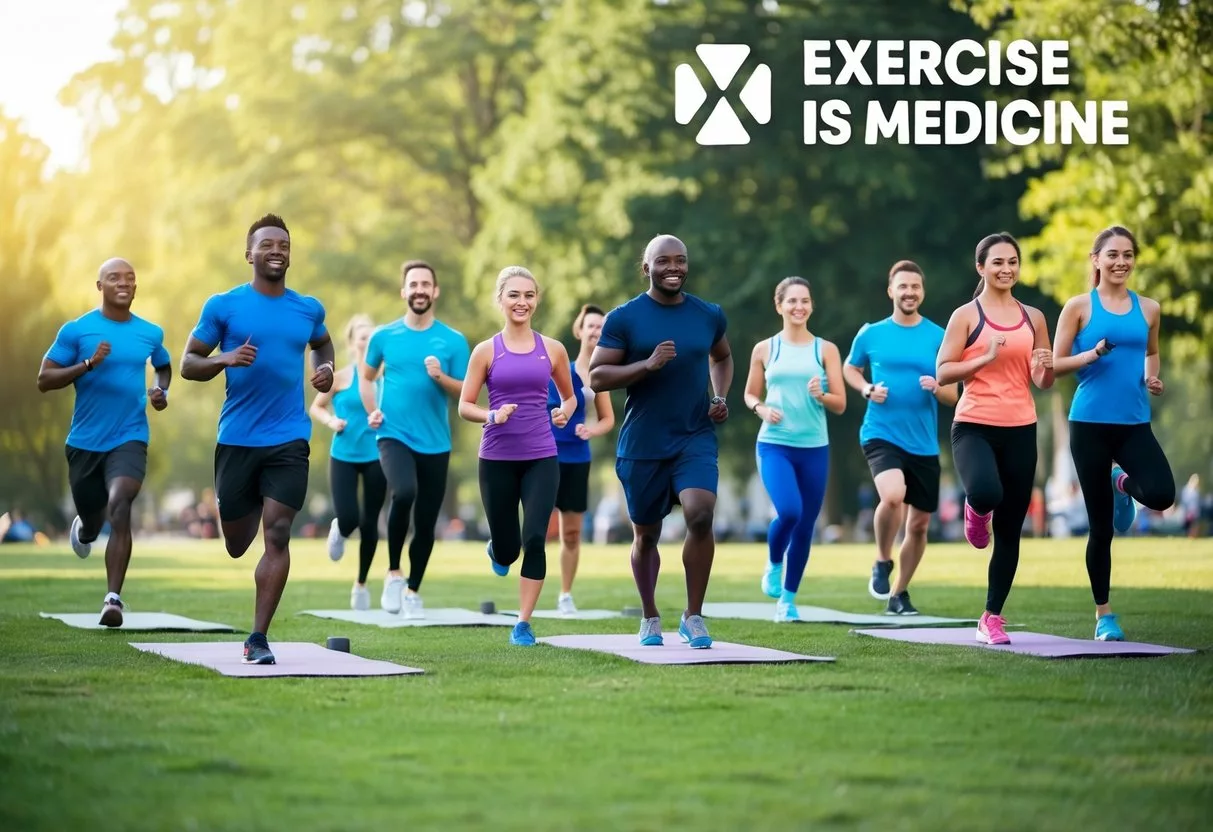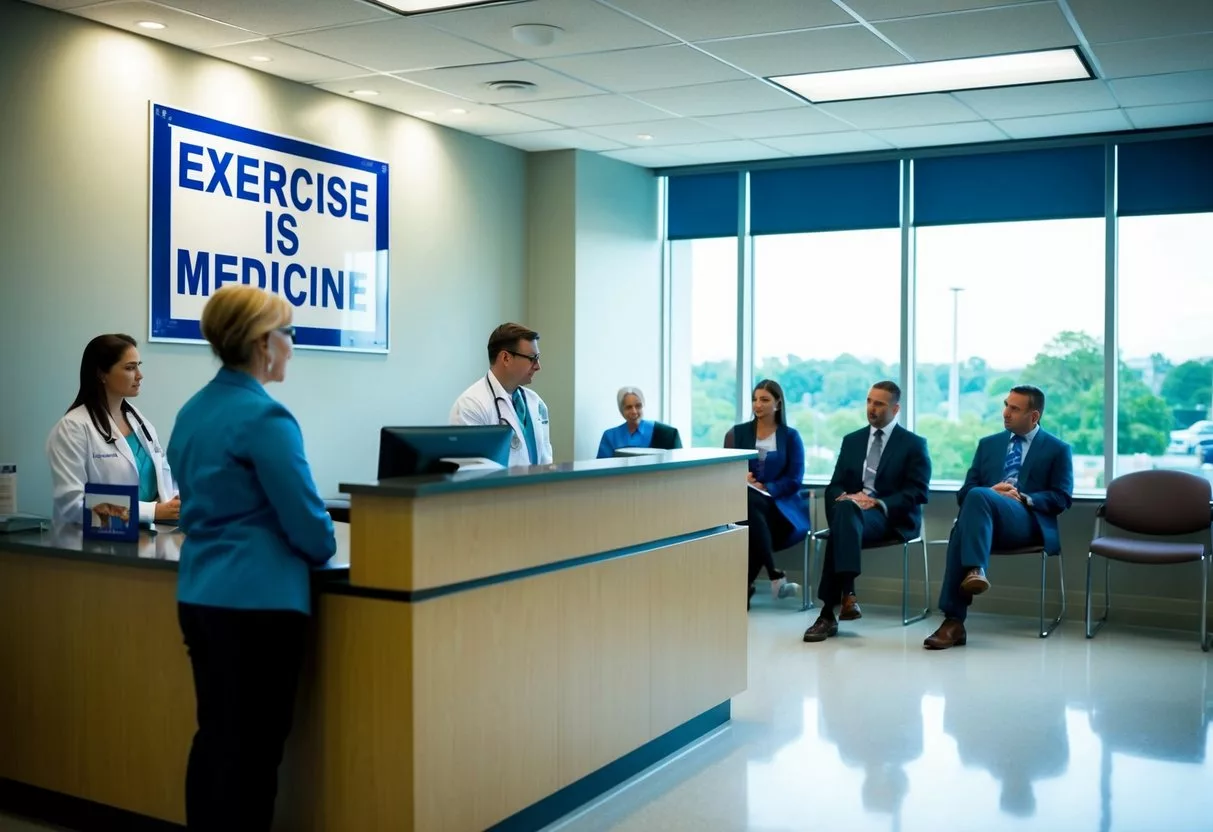The Exercise is Medicine Initiative aims to make physical activity a key part of healthcare. This global health program wants doctors to check patients’ exercise habits and give them exercise plans, just like they prescribe medicine. The American College of Sports Medicine started this effort in 2007 to boost public health.

Exercise can help prevent and treat many health issues. The initiative teaches healthcare workers about the benefits of exercise. It also helps connect patients with exercise resources in their areas. The goal is to make exercise a normal part of medical care for people of all ages and abilities.
Many countries have joined this global health push. They work to spread the idea that exercise is a powerful tool for better health. The initiative hopes to create a world where more people stay active and healthy throughout their lives.
Origins and Evolution of Exercise is Medicine

The Exercise is Medicine (EIM) initiative began in 2007 as a collaboration between medical and fitness professionals. It aimed to make physical activity a key part of disease prevention and treatment.
Role of the American College of Sports Medicine
The American College of Sports Medicine (ACSM) played a crucial role in creating EIM. ACSM partnered with the American Medical Association to launch the program. Their goal was to change how doctors think about exercise.
ACSM wanted to make physical activity assessment a standard part of patient care. They created tools and resources for healthcare providers. These helped doctors prescribe exercise like medicine.
The initiative grew quickly. ACSM trained healthcare providers worldwide. They also developed guidelines for exercise prescription.
Launching the EIM Global Network
EIM soon expanded beyond the United States. In 2010, ACSM started the EIM Global Network. This network spread the EIM message to other countries.
The Global Network helped adapt EIM for different cultures and healthcare systems. They created partnerships with health organizations worldwide.
Today, EIM has a presence in over 40 countries. Each country has its own EIM team. These teams work to promote exercise in their local healthcare systems.
The network holds regular meetings and shares best practices. This helps EIM continue to grow and improve globally.
Exercise and Public Health

Exercise plays a vital role in public health. It reduces the risk of many diseases and improves overall wellbeing. Regular physical activity benefits both individuals and communities.
Physical Activity as a Health Imperative
Physical activity is crucial for good health. It helps control weight and strengthens bones and muscles. Exercise also boosts mood and energy levels.
Adults need at least 150 minutes of moderate exercise per week. This can include brisk walking, swimming, or cycling. Children should get 60 minutes of physical activity daily.
Many people don’t meet these guidelines. Lack of exercise raises health risks. It can lead to obesity, heart disease, and diabetes.
Impact on Non-Communicable Diseases
Exercise helps prevent and manage non-communicable diseases. These include heart disease, stroke, and type 2 diabetes. Regular activity can lower blood pressure and improve cholesterol levels.
Physical activity reduces cancer risk. It helps prevent breast, colon, and lung cancers. Exercise also eases symptoms of depression and anxiety.
For older adults, staying active prevents falls. It maintains bone density and muscle strength. This helps people live independently for longer.
Public health efforts focus on increasing physical activity. This can lower healthcare costs and improve quality of life for many.
Role of Health Care Providers

Health care providers play a crucial role in promoting physical activity as part of patient care. They can integrate exercise into clinical practice and provide tailored exercise prescriptions and counseling to patients.
Integrating Exercise into Clinical Care
Health care providers can integrate physical activity into their daily practice using simple and effective tools. The Exercise is Medicine (EIM) initiative offers resources to help with this process.
Providers can use the EIM Summary Sheet for a quick overview of recommended physical activity guidelines. This helps them stay informed about current best practices.
They can also assess patients’ activity levels during routine visits. This allows them to identify those who need support in becoming more active.
Providers can make referrals to qualified exercise professionals when needed. This ensures patients receive expert guidance tailored to their specific needs.
Exercise Prescription and Counseling
Health care providers can prescribe exercise as a highly effective treatment for many chronic conditions. They determine the right “dosage” of physical activity for each patient.
Providers offer personalized exercise counseling based on a patient’s health status and goals. This may include:
- Recommending specific types of activities
- Suggesting appropriate intensity levels
- Advising on frequency and duration of exercise
They can use the EIM Rx for Health series to provide patients with condition-specific exercise information. These handouts offer clear guidance for various medical conditions.
Providers also help patients set realistic goals and overcome barriers to being active. They may schedule follow-up appointments to track progress and adjust recommendations as needed.
Assessment and Prescription

The Exercise is Medicine initiative aims to make physical activity a key part of healthcare. Doctors check how active patients are and suggest exercise plans to improve health.
Physical Activity Assessment
Doctors ask patients about their exercise habits. They may use short surveys or forms to gather this info. Some clinics track activity levels at each visit, like they do for blood pressure.
Physical activity assessment helps doctors understand a patient’s fitness. They look at how often, how long, and how hard someone exercises. This info guides recommendations for better health.
Wearable devices like step counters can also track movement. These tools give a clearer picture of daily activity. Doctors use this data to set goals and check progress.
Evidence-Based Exercise Programs
After assessing activity, doctors can suggest exercise plans. These plans are based on research showing what works best.
Evidence-based physical activity programs match a person’s health and fitness level. They include clear goals and steps to reach them. Plans might focus on walking, strength training, or other activities.
Doctors may give written exercise “prescriptions.” These list the type, time, and intensity of recommended exercise. They often start with small, doable goals and build up over time.
Some clinics partner with local gyms or community centers. This helps patients find safe places to exercise. It also connects them with trainers who understand their health needs.
Management of Chronic Diseases
Exercise plays a key role in managing many long-term health issues. It can help prevent and treat various medical conditions when used as part of a care plan.
Exercise in the Prevention and Treatment Plans
Regular physical activity helps ward off many chronic diseases. It can lower the risk of heart disease, stroke, and type 2 diabetes. For those already diagnosed, exercise is an important part of treatment.
Research shows that exercise can be as effective as some medications for certain conditions. It helps control blood sugar in diabetes and lowers blood pressure in those with hypertension.
Exercise also boosts mood and energy levels. This makes it useful for managing depression. In cancer care, physical activity can reduce fatigue and improve quality of life during treatment.
Addressing Specific Medical Conditions
Different types of exercise benefit various health issues. For example:
- Strength training helps build bone density, fighting osteoporosis
- Aerobic exercise improves heart health and aids weight loss for obesity
- Balance exercises reduce fall risk in older adults with dementia
Exercise prescriptions can be tailored to each person’s needs. A doctor or exercise specialist can create a safe, effective plan. This ensures the right type and amount of activity for each condition.
For best results, exercise should be combined with other treatments. This might include medication, diet changes, or therapy. The goal is to manage symptoms and improve overall health.
Evidence-Based Resources and Tools

The Exercise is Medicine Initiative provides valuable tools for healthcare providers and patients. These resources help make physical activity a key part of medical care and daily life.
Physical Activity Resources for Health Professionals
Healthcare providers can access evidence-based physical activity resources through the Exercise is Medicine website. These tools help doctors assess patients’ activity levels and create exercise plans.
Key resources include:
• Activity assessment forms • Exercise prescription templates • Referral guides to local fitness programs
These tools are designed to fit into a busy medical practice. They make it easier for doctors to talk about exercise with patients during short visits.
Patient Education and Handouts
The initiative offers many patient handouts on exercise benefits and safety. These cover topics like:
• How much activity adults need
• Tips for getting started with exercise
• Safety guidelines for different health conditions
The handouts use simple language and helpful graphics. Patients can take them home as reminders of their exercise goals.
EIM Rx for Health Series
The EIM Rx for Health Series gives specific exercise plans for common health issues. These include:
• Diabetes • High blood pressure • Depression
Each plan lists safe activities and how often to do them. They also explain how exercise helps manage the condition. Doctors can use these as a starting point when prescribing exercise to patients.
Exercise and Specific Populations

Exercise benefits people of all ages and backgrounds. It improves health and quality of life for different groups in unique ways.
Children and Adolescents
Regular physical activity is crucial for kids’ growth and development. It builds strong bones and muscles in children aged 3-6 years. For those 6-17 years old, exercise boosts brain function and fitness.
Exercise helps kids maintain a healthy weight. It also teaches teamwork and social skills through sports and games. Experts suggest 60 minutes of daily activity for youth.
Schools play a key role in promoting exercise. Physical education classes and recess provide opportunities for movement. After-school programs can offer more chances to be active.
Older Adults and Vulnerable Groups
Exercise is vital for older adults to stay independent. It helps prevent falls by improving balance and strength. Regular activity also keeps minds sharp and lowers the risk of dementia.
For vulnerable groups, like those with chronic illnesses, exercise can be life-changing. It helps manage conditions such as diabetes and heart disease. Even light activity is beneficial.
The Exercise is Medicine initiative promotes physical activity for all. It aims to make exercise a standard part of healthcare. Doctors can use an Exercise Vital Sign (EVS) to track patients’ activity levels.
Tailored programs help older adults exercise safely. Water aerobics and chair yoga are good low-impact options. Group classes also provide social connections, boosting mental health.
Community and Healthcare Integration

The Exercise is Medicine Initiative connects healthcare providers with community resources to promote physical activity. This integration helps patients access exercise programs and support beyond the doctor’s office.
Local and National Center Initiatives
Exercise is Medicine® (EIM) sets up local and national centers to bring together healthcare and fitness professionals. These centers create networks of doctors, nurses, and exercise specialists who work as a team.
The centers organize training programs for healthcare providers. Doctors learn how to assess patients’ activity levels and prescribe exercise. They also learn about local fitness resources to recommend.
National centers develop guidelines and tools. These help healthcare systems add physical activity screening to routine care. The EIM Global Health Network shares best practices across countries.
Community-Based Resources
Community partners play a key role in making exercise accessible. Local gyms, parks, and recreation centers offer safe spaces for physical activity.
Many communities have walking groups or free fitness classes. These provide social support and motivation for people starting an exercise routine.
Qualified exercise professionals lead programs tailored to different health needs. They work with patients referred by doctors to design safe workout plans.
Some areas have partnerships with registered dietitians. This helps people combine healthy eating with increased activity for better overall health.
Online resources like activity trackers and exercise videos supplement in-person programs. These tools help people stay active at home between community sessions.
Healthcare Economics and Exercise

Exercise plays a key role in reducing healthcare costs and improving population health. Regular physical activity offers many benefits that impact both individual wellness and broader economic factors.
Reducing Health Care Costs
Exercise can lower healthcare costs significantly. People who exercise regularly tend to need fewer doctor visits and medications. They also have shorter hospital stays when admitted.
For example, a study found that active adults spend about $1,500 less per year on healthcare than inactive adults. This adds up to major savings across the population.
Exercise helps prevent and manage chronic diseases like diabetes and heart disease. These conditions are very expensive to treat. By reducing their prevalence, exercise cuts costs for the entire healthcare system.
Impact on Population Health
Regular physical activity improves population health in many ways. It lowers rates of obesity, heart disease, and diabetes. Exercise also boosts mental health and cognitive function.
These health improvements lead to:
- Higher productivity at work
- Lower rates of disability
- Increased life expectancy
- Better quality of life
On a large scale, a healthier population means lower healthcare spending and a stronger economy. It also reduces strain on the healthcare system.
Promoting exercise as medicine can have far-reaching positive effects on public health and healthcare economics. The benefits extend beyond individual wellness to impact society as a whole.
Monitoring Health and Fitness

The Exercise is Medicine Initiative emphasizes tracking physical activity and health indicators. This approach helps healthcare providers assess patients’ wellness and tailor exercise recommendations.
Tracking Physical Activity Vital Signs
Physical activity vital signs are key measures of a person’s exercise habits. Doctors ask patients about their weekly activity levels. They record minutes of moderate to vigorous exercise.
These signs help identify inactive individuals. Healthcare providers can then offer personalized advice. They might suggest starting with short walks or joining fitness classes.
Regular tracking motivates patients to stay active. It also helps doctors spot trends in a patient’s health over time.
Incorporating Health Status Indicators
Health status indicators give a fuller picture of wellness. These include:
- Body Mass Index (BMI)
- Blood pressure
- Cholesterol levels
- Smoking status
Doctors use these alongside physical activity data. This combo helps assess overall health risks.
For example, a patient with high BMI and low activity might need a gentler exercise plan. Someone who smokes may benefit from both quitting support and increased physical activity.
Tracking these indicators over time shows the impact of exercise. Patients often see improvements in BMI and blood pressure as they become more active.
Frequently Asked Questions

The Exercise is Medicine Initiative aims to integrate physical activity into healthcare and promote its benefits. It offers certifications and works with college campuses to encourage exercise.
What are the objectives of the Exercise is Medicine Initiative?
The Exercise is Medicine Initiative seeks to make physical activity a standard part of disease prevention and treatment. It works to connect healthcare with evidence-based physical activity resources.
The initiative aims to improve public health by promoting exercise as a vital sign of health. It encourages healthcare providers to include physical activity assessments in routine care.
How does the Exercise is Medicine Initiative integrate physical activity into healthcare?
Healthcare providers are encouraged to assess patients’ physical activity levels during visits. They can then prescribe exercise or refer patients to qualified fitness professionals.
The initiative provides resources and training to help medical professionals incorporate exercise discussions into patient care. It also works to create partnerships between healthcare and fitness sectors.
What types of certification are offered through the Exercise is Medicine program?
The Exercise is Medicine program offers certifications for healthcare providers and exercise professionals. These courses teach how to effectively prescribe exercise and work with patients.
Certifications help ensure that professionals can safely guide individuals in starting and maintaining exercise programs. They cover topics like exercise assessment, prescription, and behavior change strategies.
How does Exercise is Medicine on Campus work to promote physical activity among students?
Exercise is Medicine on Campus programs organize events and initiatives to encourage student physical activity. They may set up walking groups, fitness classes, or educational workshops.
These programs often collaborate with campus health services to integrate exercise assessments into student health check-ups. They aim to create a culture of wellness and active living on college campuses.
What are the benefits of incorporating exercise into a medical treatment plan?
Exercise can help prevent and manage many chronic diseases. It improves cardiovascular health, strengthens muscles and bones, and enhances mental well-being.
Regular physical activity can reduce the need for medications in some cases. It often leads to better overall health outcomes and improved quality of life for patients.
Who are the primary advocates and supporters of the Exercise as Medicine movement?
The American College of Sports Medicine manages the Exercise is Medicine initiative. Many healthcare organizations, medical professionals, and fitness experts support the movement.
Public health agencies and some insurance companies also advocate for exercise as a form of preventive medicine. They recognize its potential to improve health outcomes and reduce healthcare costs.